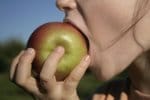For the end of this winter and even for the start of a cool spring, we appreciate vegetables like cabbages, carrots, leeks, endives, and salads.
As for fruits, why stay on the continent when you can travel to an exotic land with pineapples, kiwis, oranges, and grapefruits (etc.) and of course, doses of vitamin C. Fresh fruits are rich in vitamins and fructose, a complex sugar assimilated by the body. It is recommended to consume fruits two to three times a day. As for oil-rich fruits (hazelnuts, almonds, walnuts…), they are rich in minerals and vitamin E. However, they are very caloric and should therefore be consumed in moderation if you are overweight. So for those who take care of their figure, without feeling hungry, prefer bananas, strawberries, kiwis, grapefruits, apples. For vegetables, go for broccoli, carrots, zucchini, green beans, pumpkins, salads, tomatoes, artichokes, and eggplants.
And, above all, do not trust prejudices because some frozen or even canned fruits and vegetables keep all their virtues.
And for the summer?
It is a privileged period, so make the most of it! Eggplant, zucchini, tomato, melon, watermelon, apricot, and other red fruits are full of vitamins, minerals, and fibers, essential for health and fitness. Being low in calories, they allow you to indulge without a second thought, and, thanks to their richness in fibers and water, they have a strong satiating power.
With a low glycemic index, rich in dietary fibers, vitamins, trace elements, and water, they can be consumed raw or cooked, and have the advantage of “filling you up” for a low caloric intake. It is not by chance that it is recommended to consume five a day: their nutritional value indeed places them as anti-radical food, that is, with “anti-aging and anti-cancer” properties.
Fruits and vegetables with anticancer properties
Here are the main fruits and vegetables that are believed to have anticancer properties:
Cabbage: It contains a lot of glucosinolates, molecules that are believed to have very powerful anticancer properties found only in cruciferous vegetables.
Soy: Rich in proteins and phytoestrogens.
Garlic and onions: Bad for breath, these vegetables still have the ability to accelerate the elimination of carcinogenic toxic substances from our body.
Citrus fruits: While they are a source of vitamin C, they also contain a significant amount of monoterpenes and flavanones (two classes of anticancer compounds).
Cooked tomatoes: contain lycopene, a pigment that could inhibit the development of cancer, particularly prostate cancer.
Berries: ellagic acid (in large quantities in strawberries and raspberries) and anthocyanidins (mainly in blueberries and bilberries) can block the activity of two proteins essential to the development of cancer.


